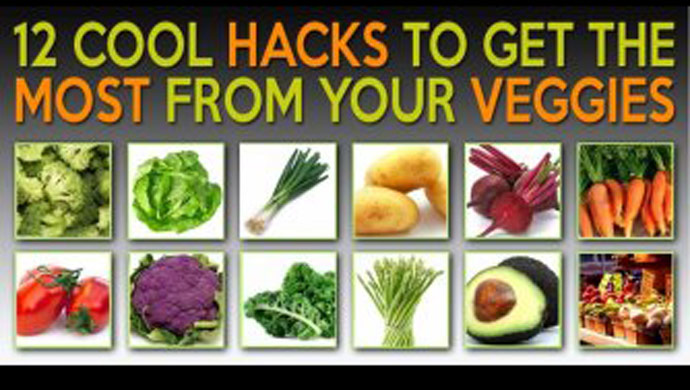12 Cool Hacks to Get the Most from Your Veggies
Broccoli is one of the most perishable vegetables yet the average time from harvest to plate is a long 7 weeks. By the time you get it home it’s lost 80% of its nutrition. For this reason try to buy broccoli at a farmer’s market and buy whole heads not cut up florets. Store in a perforated plastic bag in the fridge and eat within a day or two of purchase. Eat raw or cook minimally – steam for 4 minutes or sauté lightly.
BROCCOLI RECIPES
2. Tear up lettuce before you store it.
Most lettuce eaten in the US is iceburg. This is the least nutritious kind. The more colorful and the looser the leaf, the more nutritious it will be. One of the weirdest tips is to tear your lettuce into bite size pieces before storing. This activates it to produce more phytonutrients to protect itself from predators!
Better yet, skip lettuce and make salads with spinach, wild arugula, or radicchio, which generally more nutrition rich than lettuce.
3. Scallions trump onions.
Sweet onions are the least nutritious type of onion and scallions by far are the most nutrition dense. They contain an unbelievable 140 times more phytonutrients than white onions!
4. Buy new potatoes, organic if possible.
Potato skins contain half of a potato’s antioxidants, but it also contain most of the pesticides. For this reason, you should consider getting organic.
New potatoes cause a lower rise in blood sugar and colored potatoes that are blue, purple or almost black are the most like wild potatoes and contain the most nutrition.
5. Cook your beets.
In the US we eat very few beets, and that’s too bad! Beets are extremely nutritious and have a low glycemic index in spite of their sweetness. This is one of several vegetables that is actually healthier when eaten steamed (not boiled) or roasted instead of raw.
BEET RECIPES
6. Bye-bye baby – carrots, that is.
Carrots are hard to breakdown so cooked carrots provide more beta carotene than raw! Buying carrots with the tops left on assures they are reasonably fresh. Carrots that come in a bag can be months old.
If you rely on baby carrots for a healthy snack, you’ll be disheartened to learn that they are only misshapen big carrots that have been whittled down to baby carrot shape and are nothing special. I felt very ripped off when I learned of this, how about you?
CARROT RECIPES
7. Tomatoes – when bigger is not better.
Most people look forward to a big juicy tomato, but when choosing tomatoes, the smaller and the darker red, the better.
Tomatoes on the vine are more expensive but unless you find they taste better, you can give them a pass. Nutritionally they are not a big improvement.
Tomatoes are more nutritious when cooked. Cooking slightly changes the lycopene to a more bioavailable form.
Counterintuitively, processed tomatoes of any kind – paste, sauce, or diced – are often the most nutritious form! These tomatoes are usually cooked and processed within a few hours of harvest, retaining all their phytonutrients.
Look for tomato products that come in glass jars, BPA-free cans, or tetra packs or make your own.
(For the purists out there, tomato is actually a fruit.)
8. Choose cabbage and cauliflower’s colorful cousins.
These two veggies are the pale members of the cruciferous family and are not the most nutrient dense. Try their colorful antioxidant rich cousins instead. Red cabbage costs more than green but contains 6 times more antioxidants.
Cauliflower comes in bright green, purple and even orange. You might think these are some weird mutants, but actually it’s the other way around. The colorful versions are closer to wild forms. The white cauliflower we’re used to is a mutant albino.
9. Cook your kale.
Kale and collards come close to being as healthy as wild greens. But it’s best not to add raw greens to smoothies or salads.
Raw kale is high in oxalic acid which can lead to muscle weakness, kidney stones, gout and low thyroid function. Lightly steaming first destroys oxalic acid.
KALE RECIPES
10. Eating asparagus is a walk on the wild side.
The asparagus we eat today has barely changed from its wild ancestors and thus is one of the most nutritious vegetables. There was no need to improve on perfection! It is one more veggie best to eat steamed rather than raw. Steaming increases antioxidant availability by 30%.
11. Use an onion to keep avocados fresh.
Wild avocados (another fruit) are ½ the size of an egg and mostly pit with little flesh. It doesn’t seem possible that something so smooth and creamy could be fibrous but an avocado contains as much fiber as 2 bowls of oatmeal!
If you are left with ½ an avocado, keeping the pit in place then applying lemon juice is the old standby to keep it from turning brown. But what I find works even better is to put a thin slice of onion on top. Remove the center rings to leave room for the pit.
12. Grow your own and shop local.
Using these tips can give your more nutrition and more value for your dollar. But of course the best “veggie hack” of all is to grow your own or shop from your local farmer’s market!

